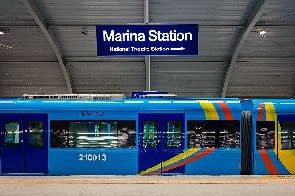 The blue line will operate 12 trips a day for two weeks, before increasing the number to 76
The blue line will operate 12 trips a day for two weeks, before increasing the number to 76
Nigeria’s gridlocked commercial hub of Lagos started operating its first light-rail system on Monday, 12 years after it first planned to start ferrying riders.
Construction of the 13-kilometer (8 mile) line began in 2009 with services slated to start in 2011, but funding constraints for the 100 billion naira ($132 million) project delayed the plan. The line built by China Civil Engineering Construction Corp. was opened by Lagos Governor Babajide Sanwo-Olu on Monday and will carry 150,000 passengers daily, according to Lagos Metropolitan Area Transport Authority.
Lagos state, home to 20 million residents, has the world’s worst traffic, according to data from Numbeo, a crowd-sourced online database. While the so-called blue line will help, Sanwo-Olu in 2021 said that the city, which lures Nigerians from across the country, needs $15 billion over five years to improve road and transportation networks.
Sanwo-Olu, wearing a train operator’s uniform for the event, moved from one coach to another announcing names of stops and occasionally speaking with passengers. When fully operational, the train will carry as many as 1,200 passengers per trip and cut the journey time from Mile 2 near the Tin Can Island — the nation’s busiest sea port — to Marina on Lagos Island to 25 minutes from as long as 3 hours.
“A mega city cannot function without an effective metro line,” said Adetilewa Adebajo, chief executive of Lagos-based CFG Advisory. “However, Lagos needs not just the metro line. It has to develop waterways too, being a coastal city. It needs an integrated transport system. Those are what will be able to relieve the congestions in the city.”
For now, traffic gridlock costs the administration about 4 trillion naira a year because of lost work-hours as commuters spend a total of 14.1 million hours a day in traffic, according to a 2021 report by Lagos-based Danne Institute of Research.
Sanwo-Olu first commissioned the blue line in December, but it couldn’t start operations because a facility to power the tracks wasn’t ready. The metro will now use a diesel locomotive for four weeks until the power plant is ready to connect to the tracks.
Such inefficiencies abound in Nigeria. In 2018, the government inaugurated a train linking the capital, Abuja, with its airport. Five years on, train cars are locked away at a depot. Meanwhile, Nigeria is spending $50 million a year paying down the project’s $500 million of loans from the Export-Import Bank of China.
Lagos has experimented with other forms of mass transit. In 2008, a World Bank-funded bus rapid transit system known as BRT-lite was introduced. About 4 million people have purchased cards needed to ride the BRT system, but it’s unable to meet the demand of the growing population.
The blue line will operate 12 trips a day for two weeks, before increasing the number to 76, with 150,000 passengers expected to travel daily, according to the state administration. The second phase of the network running from Mile 2 to Okokomaiko, which is on the way to Badagry, the state’s border with neighbouring Benin, is under construction and will bring the total length of the track to 27.5 kilometers.
Lagos state plans to complete another 37 kilometers of rail connecting the eastern and western parts of the city by the end of the year to further ease traffic. That will be called the red line and is 95% ready, Sanwo-Olu said on Monday.
Lagos — home to Dangote Cement Plc, which is controlled by Africa’s richest man Aliko Dangote, and the local units of Unilever Plc and Heineken NV — has a density of 13,800 residents per square kilometer, according to Our World in Data. That compares with 3,100 people in Johannesburg and 6,900 people in Dar es Salaam.
The Economist Intelligence Unit’s Global Livability index for 2023 rated Lagos among the least livable in a list of 173 cities.
President Bola Tinubu in June removed price caps on gasoline and allowed the naira to weaken. That resulted in a massive jump in prices of everything from transportation to food, forcing many residents in Lagos to stop driving.
Lagos residents spend the highest proportion of household budget on transport among major cities in Africa, according to the World Bank.
The metro service is expected to provide some relief to residents, according to the Lagos Metropolitan Area Transport Authority. Passengers will pay only a half of the recommended 750 naira ($0.97) for a trip, with the government subsidizing part of the cost to cushion against the rising cost of living, the agency said.
That could cost the government 1.7 billion naira monthly in subsidies if the train operates at full capacity, according to Bloomberg calculation.
“This will bring a huge relief to Lagos in terms of commuting from one point to another point,” said Frank Momoh, a businessman, who was on the metro on Monday. “I will drop my car for the train ride because it is faster and it is more convenient.”